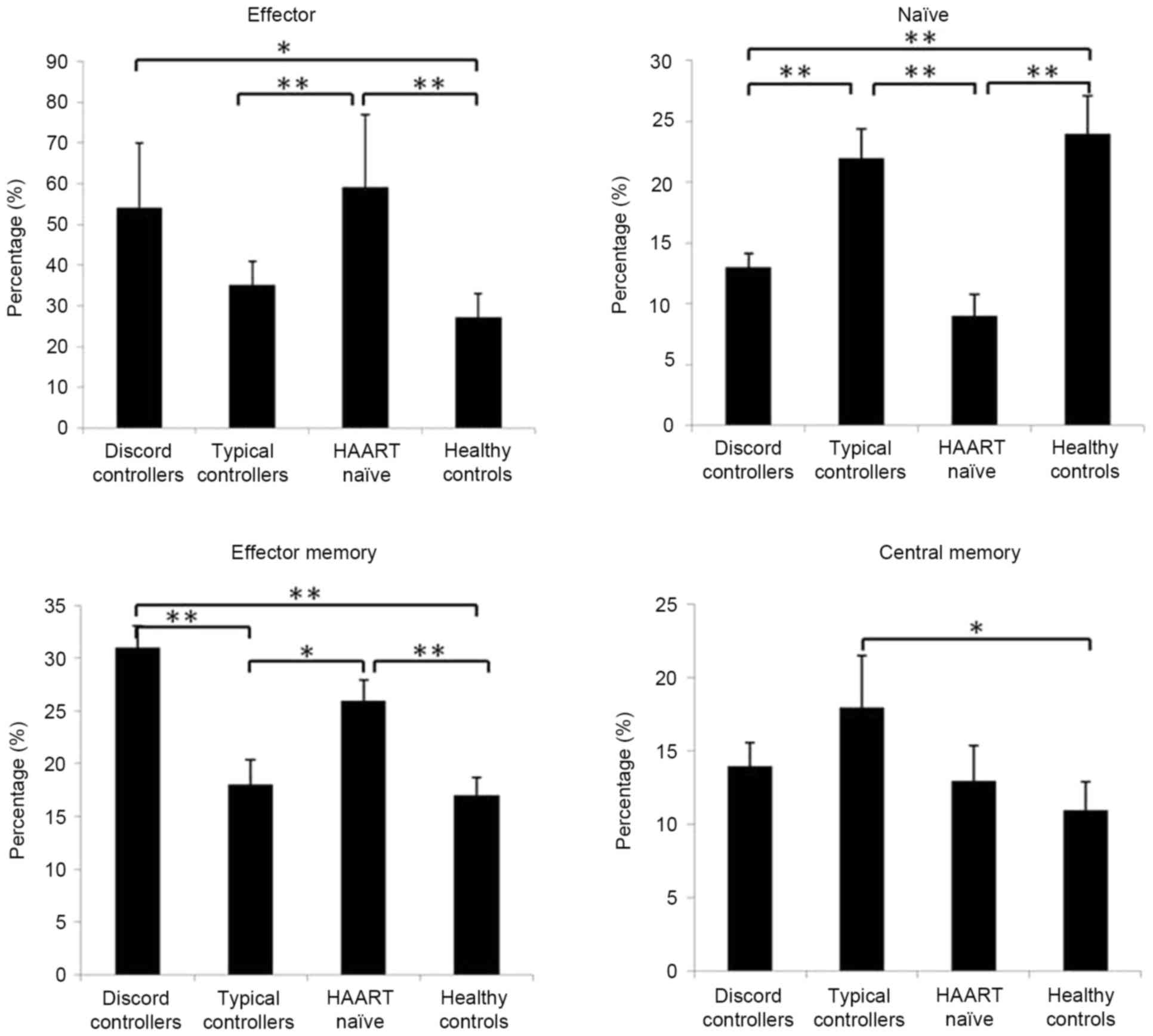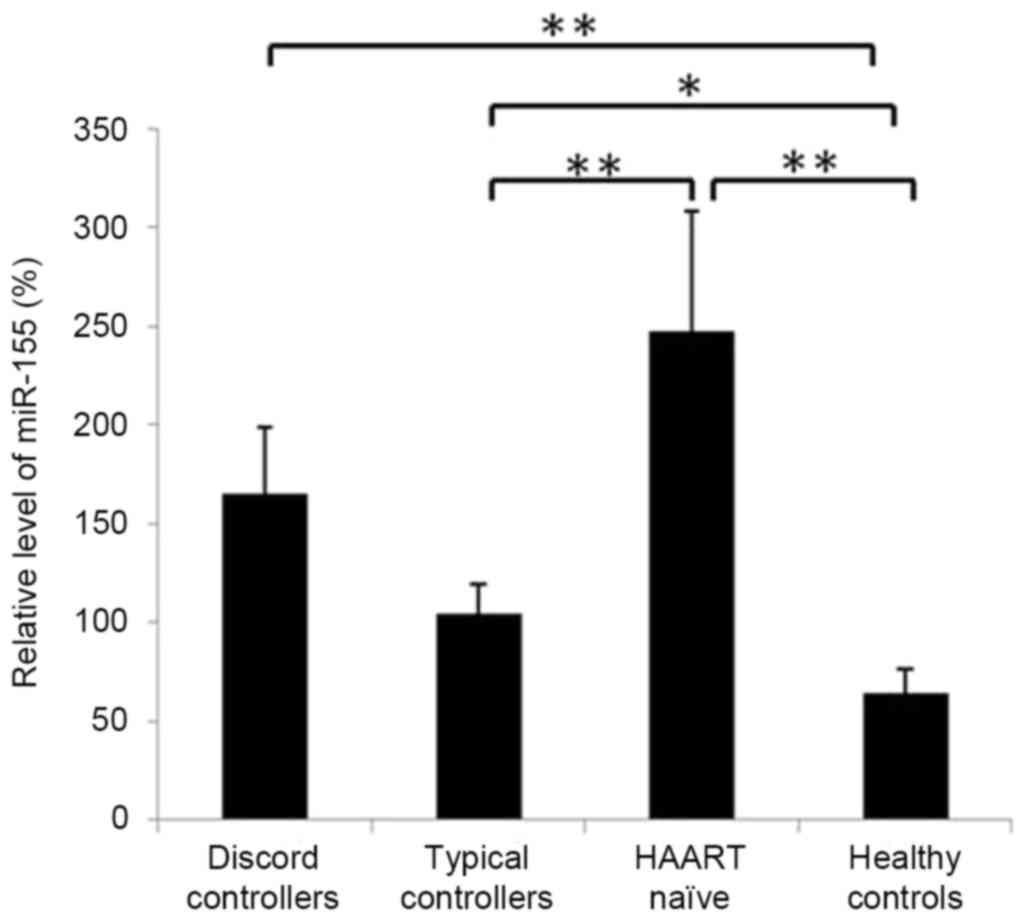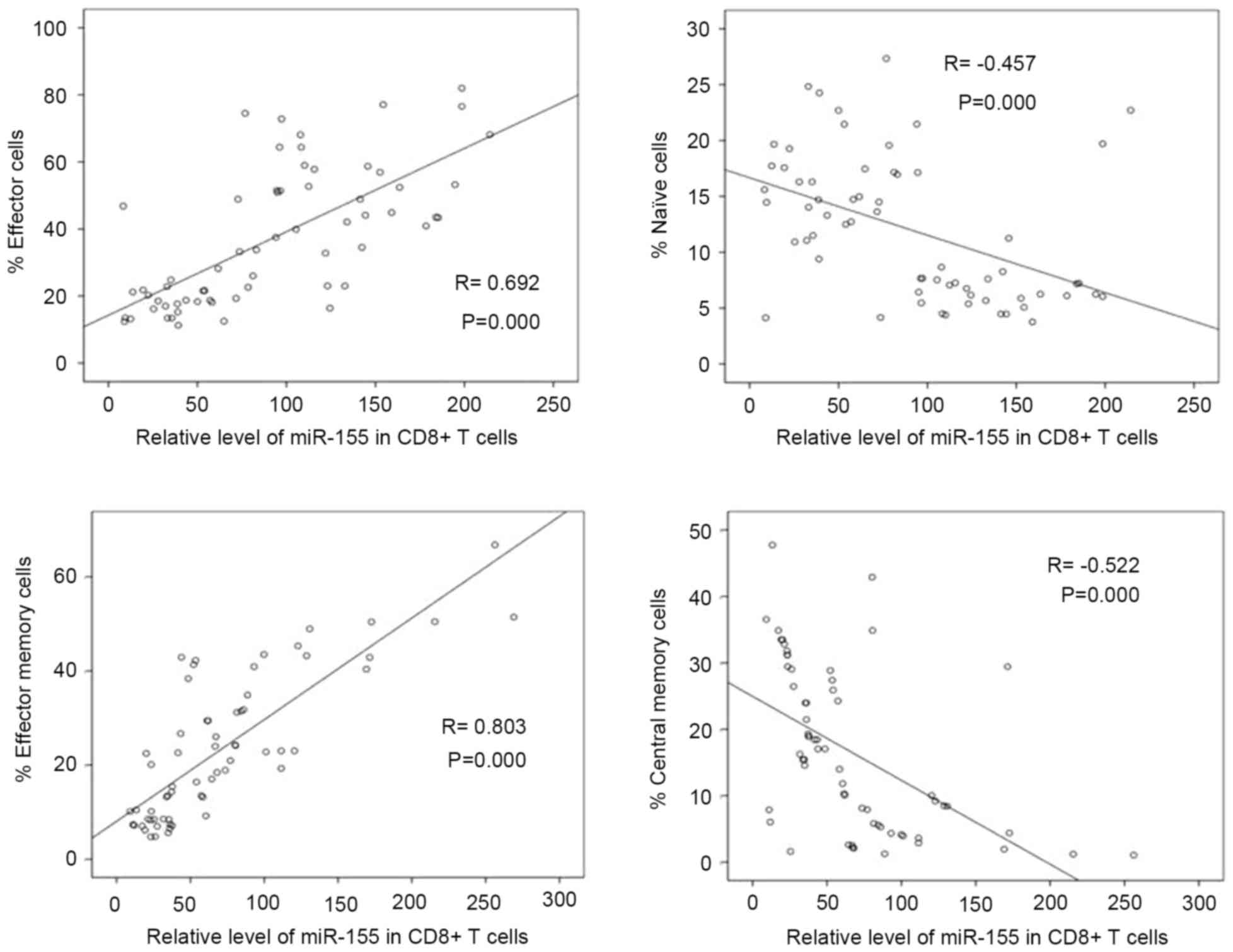|
1
|
Morou A, Palmer BE and Kaufmann DE:
Distinctive features of CD4+ T cell dysfunction in
chronic viral infections. Curr Opin HIV AIDS. 9:446–451. 2014.
View Article : Google Scholar : PubMed/NCBI
|
|
2
|
Jin CZ, Zhao Y, Zhang FJ, Yao HP, Wu LJ,
Zhao HX, Wei HS and Wu NP: Different plasma levels of interleukins
and chemokines: Comparison between children and adults with AIDS in
China. Chin Med J (Engl). 122:530–535. 2009.PubMed/NCBI
|
|
3
|
Chitra Y, Urgen S, Dayananda I and
Brajachand SN: Effect of anti retroviral therapy (ART) on CD4 T
lymphocyte count and the spectrum of opportunistic infections in
HIV/AIDS in Manipur. J Commun Dis. 41:19–24. 2009.PubMed/NCBI
|
|
4
|
Lu W, Mehraj V, Vyboh K, Cao W, Li T and
Routy JP: CD4:CD8 ratio as a frontier marker for clinical outcome,
immune dysfunction and viral reservoir size in virologically
suppressed HIV-positive patients. J Int AIDS Soc. 18:200522015.
View Article : Google Scholar : PubMed/NCBI
|
|
5
|
Serrano-Villar S, Sainz T, Lee SA, Hunt
PW, Sinclair E, Shacklett BL, Ferre AL, Hayes TL, Somsouk M, Hsue
PY, et al: HIV-Infected Individuals with low CD4/CD8 ratio despite
effective antiretroviral therapy exhibit altered T cell subsets,
heightened CD8+ T cell activation, and increased risk of
non-AIDS morbidity and mortality. PLoS Pathog. 10:e10040782014.
View Article : Google Scholar : PubMed/NCBI
|
|
6
|
Saeidi A, Buggert M, Che KF, Kong YY, Velu
V, Larsson M and Shankar EM: Regulation of CD8+ T-cell
cytotoxicity in HIV-1 infection. Cell Immunol. 298:126–133. 2015.
View Article : Google Scholar : PubMed/NCBI
|
|
7
|
Mudd JC and Lederman MM: CD8 T cell
persistence in treated HIV infection. Curr Opin HIV AIDS.
9:500–505. 2014. View Article : Google Scholar : PubMed/NCBI
|
|
8
|
Demers KR, Reuter MA and Betts MR: CD8(+)
T-cell effector function and transcriptional regulation during HIV
pathogenesis. Immunol Rev. 254:190–206. 2013. View Article : Google Scholar : PubMed/NCBI
|
|
9
|
Cao W, Mehraj V, Kaufmann DE, Li T and
Routy JP: Elevation and persistence of CD8 T-cells in HIV
infection: The Achilles heel in the ART era. J Int AIDS Soc.
19:206972016. View Article : Google Scholar : PubMed/NCBI
|
|
10
|
Allantaz F, Cheng DT, Bergauer T,
Ravindran P, Rossier MF, Ebeling M, Badi L, Reis B, Bitter H,
D'Asaro M, et al: Expression profiling of human immune cell subsets
identifies miRNA-mRNA regulatory relationships correlated with cell
type specific expression. PLoS One. 7:e299792012. View Article : Google Scholar : PubMed/NCBI
|
|
11
|
Ooi AG, Sahoo D, Adorno M, Wang Y,
Weissman IL and Park CY: MicroRNA-125b expands hematopoietic stem
cells and enriches for the lymphoid-balanced and lymphoid-biased
subsets. Proc Natl Acad Sci USA. 107:21505–21510. 2010. View Article : Google Scholar : PubMed/NCBI
|
|
12
|
Zhang N and Bevan MJ: Dicer controls
CD8+ T-cell activation, migration, and survival. Proc
Natl Acad Sci USA. 107:21629–21634. 2010. View Article : Google Scholar : PubMed/NCBI
|
|
13
|
Salaun B, Yamamoto T, Badran B,
Tsunetsugu-Yokota Y, Roux A, Baitsch L, Rouas R, Fayyad-Kazan H,
Baumgaertner P, Devevre E, et al: Differentiation associated
regulation of microRNA expression in vivo in human CD8+
T cell subsets. J Transl Med. 9:442011. View Article : Google Scholar : PubMed/NCBI
|
|
14
|
Tsai CY, Allie SR, Zhang W and Usherwood
EJ: MicroRNA miR-155 affects antiviral effector and effector Memory
CD8 T cell differentiation. J Virol. 87:2348–2351. 2013. View Article : Google Scholar : PubMed/NCBI
|
|
15
|
Singh UP, Murphy AE, Enos RT, Shamran HA,
Singh NP, Guan H, Hegde VL, Fan D, Price RL, Taub DD, et al:
miR-155 deficiency protects mice from experimental colitis by
reducing T helper type 1/type 17 responses. Immunology.
143:478–489. 2014. View Article : Google Scholar : PubMed/NCBI
|
|
16
|
Yao R, Ma YL, Liang W, Li HH, Ma ZJ, Yu X
and Liao YH: MicroRNA-155 modulates Treg and Th17 cells
differentiation and Th17 cell function by targeting SOCS1. PLoS
One. 7:e460822012. View Article : Google Scholar : PubMed/NCBI
|
|
17
|
Livak KJ and Schmittgen TD: Analysis of
relative gene expression data using real-time quantitative PCR and
the 2(−Delta Delta C(T)) Method. Methods. 25:402–408. 2001.
View Article : Google Scholar : PubMed/NCBI
|
|
18
|
Pender MP, Csurhes PA, Pfluger CM and
Burrows SR: Deficiency of CD8+ effector memory T cells
is an early and persistent feature of multiple sclerosis. Mult
Scler. 20:1825–1832. 2014. View Article : Google Scholar : PubMed/NCBI
|
|
19
|
Groves KC, Bibby DF, Clark DA, Isaksen A,
Deayton JR, Anderson J, Orkin C, Stagg AJ and McKnight A: Disease
progression in HIV-1-infected viremic controllers. J Acquir Immune
Defic Syndr. 61:407–416. 2012. View Article : Google Scholar : PubMed/NCBI
|
|
20
|
Mohan T, Bhatnagar S, Gupta DL and Rao DN:
Current understanding of HIV-1 and T-cell adaptive immunity:
Progress to date. Microb Pathog. 73:60–69. 2014. View Article : Google Scholar : PubMed/NCBI
|
|
21
|
Prlic M, Williams MA and Bevan MJ:
Requirements for CD8 T-cell priming, memory generation and
maintenance. Curr Opin Immunol. 19:315–319. 2007. View Article : Google Scholar : PubMed/NCBI
|
|
22
|
Joshi NS and Kaech SM: Effector CD8 T cell
development: A balancing act between memory cell potential and
terminal differentiation. J Immunol. 180:1309–1315. 2008.
View Article : Google Scholar : PubMed/NCBI
|
|
23
|
Papagno L, Spina CA, Marchant A, Salio M,
Rufer N, Little S, Dong T, Chesney G, Waters A, Easterbrook P, et
al: Immune activation and CD8+ T-cell differentiation
towards senescence in HIV-1 infection. PLoS Biol. 2:E202004.
View Article : Google Scholar : PubMed/NCBI
|
|
24
|
Appay V, Papagno L, Spina CA, Hansasuta P,
King A, Jones L, Ogg GS, Little S, McMichael AJ, Richman DD and
Rowland-Jones SL: Dynamics of T cell responses in HIV infection. J
Immunol. 168:3660–3666. 2002. View Article : Google Scholar : PubMed/NCBI
|
|
25
|
Seddiki N, Brezar V, Ruffin N, Lévy Y and
Swaminathan S: Role of miR-155 in the regulation of lymphocyte
immune function and disease. Immunology. 142:32–38. 2014.
View Article : Google Scholar : PubMed/NCBI
|
|
26
|
Landgraf P, Rusu M, Sheridan R, Sewer A,
Iovino N, Aravin A, Pfeffer S, Rice A, Kamphorst AO, Landthaler M,
et al: A mammalian microRNA expression atlas based on small RNA
library sequencing. Cell. 129:1401–1414. 2007. View Article : Google Scholar : PubMed/NCBI
|
|
27
|
Escobar T, Yu CR, Muljo SA and Egwuagu CE:
STAT3 activates miR-155 in Th17 cells and acts in concert to
promote experimental autoimmune uveitis. Invest Ophthalmol Vis Sci.
54:4017–4025. 2013. View Article : Google Scholar : PubMed/NCBI
|
|
28
|
Thai TH, Calado DP, Casola S, Ansel KM,
Xiao C, Xue Y, Murphy A, Frendewey D, Valenzuela D, Kutok JL, et
al: Regulation of the germinal center response by microRNA-155.
Science. 316:604–608. 2007. View Article : Google Scholar : PubMed/NCBI
|
|
29
|
Gracias DT, Stelekati E, Hope JL,
Boesteanu AC, Doering TA, Norton J, Mueller YM, Fraietta JA, Wherry
EJ, Turner M and Katsikis PD: The microRNA miR-155 controls CD8 (+)
T cell responses by regulating interferon signaling. Nat Immunol.
14:593–602. 2013. View Article : Google Scholar : PubMed/NCBI
|
|
30
|
Lind EF, Elford AR and Ohashi PS:
Micro-RNA 155 is required for optimal CD8+ T cell
responses to acute viral and intracellular bacterial challenges. J
Immunol. 190:1210–1216. 2013. View Article : Google Scholar : PubMed/NCBI
|
|
31
|
Bignami F, Pilotti E, Bertoncelli L, Ronzi
P, Gulli M, Marmiroli N, Magnani G, Pinti M, Lopalco L, Mussini C,
et al: Stable changes in CD4+ T lymphocyte miRNA
expression after exposure to HIV-1. Blood. 119:6259–6267. 2012.
View Article : Google Scholar : PubMed/NCBI
|
|
32
|
Seddiki N, Swaminathan S, Phetsouphanh C
and Kelleher AD: miR-155 is differentially expressed in Treg
subsets, which may explain expression level differences of miR-155
in HIV-1 infected patients. Blood. 119:6396–6397. 2012. View Article : Google Scholar : PubMed/NCBI
|
|
33
|
Martinez-Nunez RT, Louafi F, Friedmann PS
and Sanchez-Elsner T: MicroRNA-155 modulates the pathogen binding
ability of dendritic cells (DCs) by down-regulation of DC-specific
intercellular adhesion molecule-3 grabbing non-integrin (DC-SIGN).
J Biol Chem. 284:16334–16342. 2009. View Article : Google Scholar : PubMed/NCBI
|












